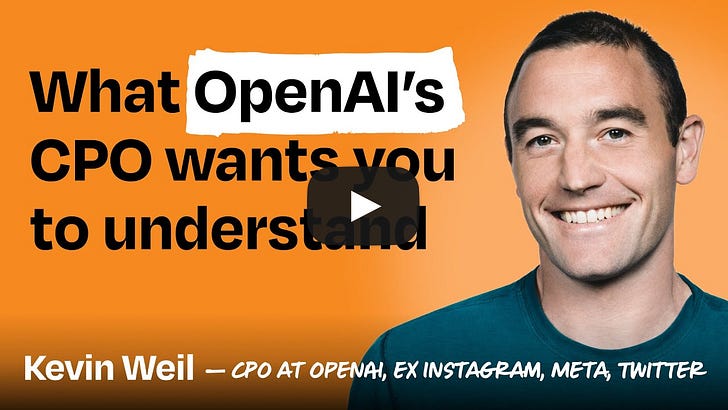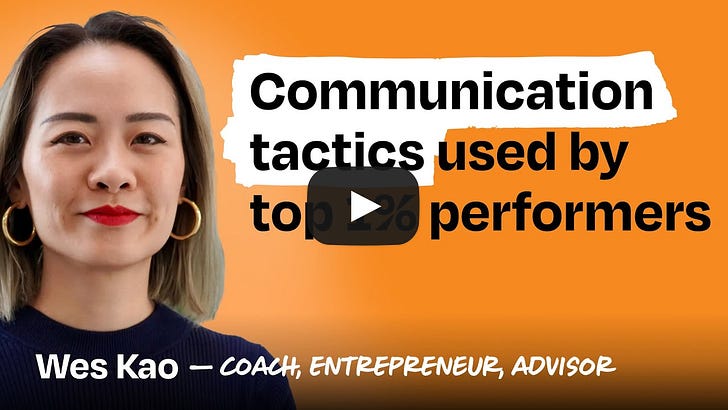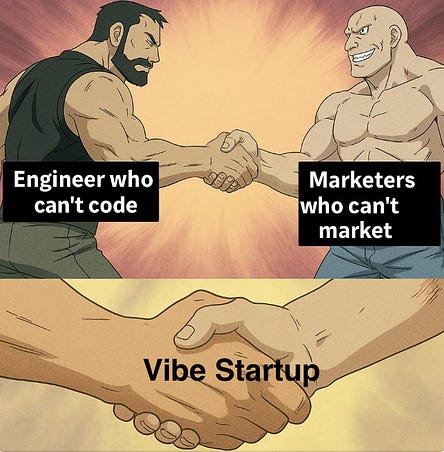🧠 Community Wisdom: Learning to be more concise, reviewing design works, creating a strategy pre-PMF, moving from…
👋 Hello and welcome to this week’s edition of ✨ Community Wisdom ✨ a subscriber-only email, delivered every Saturday, highlighting the most helpful conversations in our members-only Slack community. A big thank-you to this month’s community sponsor, Merge! Merge makes integrating with your customers’ software vendors easy. Add hundreds of integrations to your B2B SaaS products, with unified APIs for file storage, ticketing, CRM, ATS, HRIS, and accounting. AI companies love Merge because it delivers instant, secure access to clean customer data that powers their solutions. Stop wasting countless engineering hours staying ahead of breaking API changes and digging through a backlog of integration support tickets. Merge handles the full integration lifecycle so you can focus on what matters most: building your core product! ✨ Upcoming community meetups ✨Upcoming community-organized meetups—click the city name to RSVP:
Can’t find your city and want to host one? Just DM @Riya in our Slack. It takes 10 minutes (i.e. pick a date and location), and you get to meet awesome people from our community. Learn more here. 🎙️ New podcast episodes this weekOpenAI’s CPO on how AI changes must-have skills, moats, coding, startup playbooks, more | Kevin Weil (CPO at OpenAI, ex-Instagram, Twitter): YouTube, Apple, Spotify  Become a better communicator: Specific frameworks to improve your clarity, influence, and impact | Wes Kao (coach, entrepreneur, advisor): YouTube, Apple, Spotify  💥 Top threads this week1. Learning to be more concise
Joni Hoadley: One of the best things you can do is collaborate with your team to experiment with a few different communication techniques and see what lands best. Two that I often recommend are the Minto Pyramid Principle for crisp, top-down thinking, and Amazon’s 6-pager for more strategic, narrative-driven planning. I just wrote a blog post on this topic—especially how storytelling plays a big role in career growth as a PM. My article provides more context about the two communication techniques I mentioned, plus 2 additional ones. You can check it out here: https://jonihoadley.com/product-management-storytelling-career-growth/. And for what it’s worth, I’ve led a few workshops on this recently—if anyone’s interested in digging deeper, feel free to DM me! Alex Dou: I like Smart Brevity and BLUF (Bottom Line Up Front) as frameworks for getting the muscle into your team. I think you have to (1) have an opinion on the framework and (2) be the reviewer until the feedback loop gets ingrained. Maybe that means that you have to review all weekly status updates and hammer home the BLUF and Smart Brevity formats over 1 month. But then as people start doing it naturally, you can probably back off and it will spread to other artifacts. Additional thoughts:
James Conway: I reference The So What Strategy every time I have to do an exec briefing. gary: Wen: New podcast from Lenny that reminds me of this post! 2. Creating a strategy pre-PMF
Matt Gonzales: I’ve had to build product strategy for a few orgs, of varying sizes, and in similar situations as you. I generally focus on a few key points and I don’t over-index on any particular detail because, as you allude to, it’s likely to change. For example, I might establish a broad vision of “we want to be the X for Y so people can Z,” outline a few things I think we need to accomplish to get there (e.g. “Identify our ICP,” “Solve {some} singular, important problem really well,” and “Prioritize breadth over depth”), and focus particularly on defining who we think our ICP and user/buyer personas are. The idea being that this initial strategy can serve as your hypothesis. The market, competitive, and customer research you do have can inform this first hypothesis, and then you can add or update information as you learn more. In pre-PMF, it’s tough, because you may need to be more reactive to customer asks and worry about intentional strategy later and trying to balance that with things you think might fit your strategy (now or later). Having some sort of high-level, somewhat vague strategy can help give you enough room to stretch and figure out where PMF is while still having somewhat of a north star. As you build more things and capture more customers, you’ll likely start to see your ICP and PMF emerge. An art, not a science (imo), so you just do your best with the information you have to work with. Miroslav Pavelek: What situation you are currently in? What problem are you trying to solve by this deck? Derrek: +1 on what @Matt Gonzales said. If you’re pre-PMF, then I think the product strategy should be focused on the fastest path to finding PMF. What’s your strategy to do that? A high-level strategy that defines how you’re going to find PMF should be a bit more evergreen for your team until you start to find PMF, at which point you’ll want to start validating that and scaling. That’s not to say your roadmap will be stable; your strategy will probably be to not have a roadmap that goes very far out, but rather something that enables you to rapidly test hypotheses to get to PMF. Roberto Mendoza: Very helpful, @Matt Gonzales, and reinforces some of what I was already thinking. @Miroslav Pavelek, focus our org/founders on a strategy vs. being a feature factory. @Derrek, so focusing the strategy on getting to PMF, thank you. Joshua Herzig-Marx: First off, nobody* is good at strategy! (Though @Adam Fishman wrote a great piece.) And lots of startup leaders will tell you that writing down your strategy at this stage is a bad idea. But I think it’s the perfect time. Why? Because articulating your strategy in writing provides an affordance for improving it. Make it simple. Your strategy needs three parts:
You can sit down and write it out, or build it by observing the daily workings and decisions of the company, or both. Maybe you have a monthly strategy review meeting. And maybe one of your values is “Product excellence: we fix every bug immediately.” And someone says, “Hey—we’re drowning in minor bugs and not advancing our core product!” You can respond, “Have we learned something new about ourselves? Should we reexamine that operating principle?” *OK, technically not nobody, but I’d argue that good strategy is better thought of as an emergent, organizational capability rather than an individual skill. Roberto Mendoza: Helpful, @Joshua Herzig-Marx. Evan Michner: To all of the comments above! Agree, @Roberto Mendoza—you need some sort of vision or opinion on the what/for whom. Your “product strategy” at this stage should lay out a structured approach to finding PMF, rather than executing on a predetermined vision like you would for a more established product. And that structured approach should center on learning as fast as possible. Think of your strategy more like a hypothesis that lays out a learning plan to help fuel prioritization. Probably a paragraph or two with some bullets that includes what success looks like—which, at PMF stage, is largely measured in conviction (comprised of some quant, some qual, and some gut!). Test it by putting it in front of some of your engineering counterparts—is there enough context to help make decisions? Above all: whatever it is, write it down. Writing helps thinking, plus the artifact is out there for all! Love @Joshua Herzig-Marx’s comment about milestones. I’ve even used “learning milestones” in similar projects. Define what you need to learn about your customers and market, which would guide the tactics/work you do. Fun stuff! Joshua Herzig-Marx: I also like milestones because it’s a reminder you need them to line up between GTM and tech. Ken Romano: I went through this a couple of months ago. We had just solidified product-market fit but not so much that I could be 100% prescriptive on where we were headed. So a few things that helped me:
3. When should you incorporate your startup?
Ana: You can incorporate in a state with less to no tax. Or is this something only for foreign LLC owners? Isaac Krasny: This is mostly about your desired risk tolerance, but I usually try to avoid incorporating until I need to collect payments or sign contracts. That said, and while I totally hear you on the tax stuff, if you’re just creating a sole proprietorship or simple structure without a massive number of transactions, the tax reporting is pretty straightforward. Maybe a couple hours per year. Peter Berg: So, there are no tax implications to creating an LLC unless you have partners. An LLC by default is a pass-through entity for taxation purposes. You should be able to create one for ~$400 on Rocket Lawyer or a similar site. I would incorporate it in Delaware because any lawyer you work with will understand how a Delaware LLC works. Marisa Fagan: A quick google search told me “Since 2024, every California LLC is required to pay the first year Annual Franchise Tax of $800.” Which is just enough $ to make me pause before filing. I suppose if it’s an annual fee, I’m just delaying the inevitable if I plan to incorporate anytime this year. Isaac Krasny: 100% not a lawyer, but you might also explore incorporating in Delaware, Wyoming, Texas. Also, those Cali fees don’t mess around—here in Vermont, it’s $150 to incorporate and $40/year annual reporting fee thereafter. San Gunawardana: Incorporating in another state doesn’t get you out of having to pay the $800 Cal Franchise tax if you’re doing business in the state (I’ll amplify that Cal FTB is relentless). Verdi: Yeah, but come on, let’s be real. The state government doesn’t have time or resources to do a P0 manhunt against an online entrepreneur clearing less than 5K in revenue. They have much bigger fish to fry. At this stage, it’s a huge distraction, IMO. If you have the money to throw at this without batting an eye, by all means do it, but by your response, it seems like you don’t. So it’s a better ROI of your time chasing customers, and revenue, and once you have made sufficient revenue, use that income to square some of these things out. Getting tangled up in paperwork right before you enter the race is an excellent way to kill your momentum. 4. Building trust with customer support
Miroslav Pavelek: I’ve never heard anyone from Sales or CS say, “Thanks to Product, my targets are easier now—go ahead and increase them.” So it’s natural for them to push back. That said, here are a few more serious areas to dig into:
David Jorjani: Miroslav said it and I’ll reiterate the part I wanted to highlight. In a growing startup, resources are limited, and likely product and Eng are the bottleneck in many teams, so before a strong product leader, it becomes a battle of forces in a way. In my experience (I’ve led product at seed -> Series A twice), connecting the dots to the bigger goals and the bigger pains and conveying the bigger team/company goals becomes essential. Also, after a certain point, someone will need to bring the CEO in as well because we need to maintain the product and customers we have, as opposed to purely chase new ones. It is a delicate balance and requires a lot of tactful communication and influence from the new central hub, which usually is the product leader or the ops leader. Evan Goldin: Encourage the CEO to connect with support often. I’m CEO of a similar-size org, and I’m still responding to support tickets directly, to help feel the pain. Be warned of the flip side, that it drives CS nuts sometimes to have me in the inbox. Tony Haenn: I stepped into a VP of Product role at a B2B SaaS where the CS team felt very similarly about the product team. In addition to the communication processes you laid out, I’d also suggest having regular 1:1s with the Head of CS and each CS person. It doesn’t have to be weekly; monthly for Head of CS and quarterly for each CS person was what I did. I also encouraged my PMs to do the same with the CS team. It was the relationship-building along with the communication that helped repair the relationship between the teams. The only other communication thing we did was a quarterly “voice of the customer,” where the customer success, sales and customer support teams all had an hour to present on what they were hearing from the market. Product just sat and listened. For those teams, it gave them an outlet where they drove the agenda and the content. This helped them feel like they had more agency and input, vs. a product-led meeting where they provide input. The last thing I did was emphasize to the Product team that we cared about revenue. We measured other things and built for the user. But at the end of the day, if it’s not selling, it’s not a good product. I think that emphasis helped influence how some of the PMs engaged with the CS team (and sales team). 5. Reviewing design works
Rachel Hechter: For little things, the designs just get attached to the tickets and discussed during refinement. For anything more substantial, the designer hosts design reviews with the PM and lead engineer (and others as needed). But we’re very small, and there is no “head of design” who needs to review their reports’ designs. Krishna AG: We do product team reviews, a quick cross-functional review and test it with 2-3 customers who are particularly thoughtful. gary: Designers host design alignment meetings with the PM, engineer(s), QA involved for overall design quality, and the design lead would give timely feedback async. Sometimes he joins the design alignment meetings for minor fixes or enhancements, and it’s discussed in a ticket’s comment thread. Jason McCoy: Plus-1 to what @gary said. Ideally, the design lead walks the PM and tech lead (plus frontend/backend engineers) through the final spec to review the UX and discuss all implementation details. This meeting should happen a week or two before the sprint cycle kicks off so that there’s time to triage any gaps/concerns. Furthermore, it’s important that a tech lead has been involved throughout the design phase, helping to give feedback on architectural implications, data structures, and UI patterns on the client side. This helps minimize surprises later in the design phase when you’re working to transition the project to implementation. gary: Need to share more context. My team builds products for a highly regulated space, so the design lead is more focused on ensuring the designers are productive, efficient and capable. There are tons of implementation details that are not sustainable for the design lead to keep an eye on or walk through them with the cross-functional team because of better context and better visibility on the big picture. The design lead is more focused on system coherence, cross-product impact, and high-level UX/UI inconsistencies. To sum it up:
6. Moving from product management to product design
Erika Klics: @Maxym Nesmashny, there are so many different “flavors” of Product Manager:
I’ve seen companies look for all of these flavors in the past. My best advice is to find the points in your career when you acted like a PM and define that story for yourself so that when the right company is looking for your flavor, you’ll be ready to nail their process. Miroslav Pavelek: If you find yourself constantly doing the PM role—make it official. Ask in your company if you can officially do both roles (Product Designer + Product Manager) for some feature/initiative/product/project. That way:
Derrek: I made the switch from design into PM a bit over 13 years ago. I came from a marketing/interactive design background with some experience doing product design. I’ve also mentored designers, QAs, and others that have made the switch into or out of product management. My personal path was taking on a role at a small startup that needed a product designer/product manager. The hiring manager was a former client of mine and that helped me get in the door. The great thing about small startups is that they need people to do a lot of different things, and so you can quickly gain a huge range of experiences. They are also often more flexible on titles, which can help you negotiate a split title or a transition of your title over time. Getting that first official PM title will open up doors for you later. If you’re in a good place with your current company, I recommend formally discussing it with your manager and fellow PM colleagues. Usually there is a PM leader willing to mentor someone into the role that is motivated, but you’ll need support from your current manager. James Conway: Some excellent advice here. What I would add: you are not your job title.
John Conneely: Obligatory link to more context and the GPT bot. 🤓 Top finds
😂 Meme of the weekHave a fulfilling and productive week 🙏 If anyone in your life would benefit from this newsletter or community, consider giving them a gift subscription 💞 There are group discounts, gift options, and referral bonuses available. Sincerely, Kiyani 👋 Invite your friends and earn rewardsIf you enjoy Lenny's Newsletter, share it with your friends and earn rewards when they subscribe. |
Similar newsletters
There are other similar shared emails that you might be interested in:
- 🧠 Community Wisdom: Essential reading for early-stage founders, balancing unlimited SaaS plans with profitability…
- 🧠 Community Wisdom: Finding your voice on established teams, focus tips for ADHD brains, how to best use Granola,…
- 🧠 Community Wisdom: Designing great performance review templates, balancing oversight and autonomy with junior te…

